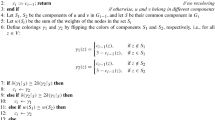Abstract
Given a complete binary tree of height h, the online tree node assignment problem is to serve a sequence of assignment/release requests, where an assignment request, with an integer parameter 0≤i≤h, is served by assigning a (tree) node of level (or height) i and a release request is served by releasing a specified assigned node. The node assignments have to guarantee that no node is assigned to two assignment requests unreleased, and every leaf-to-root path of the tree contains at most one assigned node. With assigned node reassignments allowed, the target of the problem is to minimize the number of assignments/reassignments, i.e., the cost, to serve the whole sequence of requests. This online tree node assignment problem is fundamental to many applications, including OVSF code assignment in WCDMA networks, buddy memory allocation and hypercube subcube allocation.
Most of the previous results focus on how to achieve good performance when the same amount of resource is given to both the online and the optimal offline algorithms, i.e., one tree. In this paper, we focus on resource augmentation, where the online algorithm is allowed to use more trees than the optimal offline algorithm. By using different approaches, we give (1) a 1-competitive online algorithm, which uses (h+1)/2 trees and is optimal because (h+1)/2 trees are required by any online algorithm to match the cost of the optimal offline algorithm with one tree; (2) a 2-competitive algorithm with 3h/8+2 trees; (3) an amortized 8/3-competitive algorithm with 11/4 trees; (4) a general amortized (4/3+α)-competitive algorithm with (11/4+4/(3α)) trees, for 0<α≤4/3.
Similar content being viewed by others
References
Brodal GS, Demaine ED, Munro JI (2005) Fast allocation and deallocation with an improved buddy system. Acta Inform 41(4–5):273–291
Chin FYL, Ting H-F, Zhang Y (2007) A constant-competitive algorithm for online ovsf code assignment. In: Proceedings of the 18th international symposium on algorithms and computation (ISAAC), pp 452–463. (The paper is to appear in Algorithmica)
Chin FYL, Ting H-F, Zhang Y (2008) Constant-competitive tree node assignment. Manuscript
Chin FYL, Zhang Y, Zhu H (2007) Online OVSF code assignment with resource augmentation. In: Proceedings of the third international conference on algorithmic aspects in information and management (AAIM), pp 191–200
Defoe DC, Cholleti SR, Cytron R (2005) Upper bound for defragmenting buddy heaps. In: Proceedings of the 2005. ACM SIGPLAN/SIGBED conference on languages, compilers, and tools for embedded systems, pp 222–229
Dutt S, Hayes JP (1991) Subcube allocation in hypercube computers. IEEE Trans Comput 40(3):341–352
Erlebach T, Jacob R, Mihalák M, Nunkesser M, Szabó G, Widmayer P (2007) An algorithmic view on OVSF code assignment. Algorithmica 47(3):269–298
Erlebach T, Jacob R, Tomamichel M (2005) Algorithmische Aspekte von OVSF Code Assignment mit Schwerpunkt auf Offline Code Assignment. Student thesis at ETH Zürich
Forisek M, Katreniak B, Katreniaková J, Kralovic R, Královic R, Koutný V, Pardubská D, Plachetka T, Rovan B (2007) Online bandwidth allocation. In: Proceedings of the 15th annual European symposium on algorithms (ESA), pp 546–557
Kalyanasundaram B, Pruhs K (2000) Speed is as powerful as clairvoyance. J ACM 47(4):617–643
Knowlton KC (1965) A fast storage allocator. Commun ACM 8(10):623–624
Knuth DE (1975) The art of computer programming, volume 1: fundamental algorithms. Addison-Wesley, Reading
Li X-Y, Wan P-J (2005) Theoretically good distributed CDMA/OVSF code assignment for wireless ad hoc networks. In: Proceedings of the 11th annual international conference of computing and combinatorics (COCOON), pp 126–135
Minn T, Siu K-Y (2000) Dynamic assignment of orthogonal variable-spreading-factor codes in W-CDMA. IEEE J Sel Areas Commun 18(8):1429–1440
Miyazaki S, Okamoto K (2008) Improving the competitive ratio of the online OVSF code assignment problem. In: Proceedings of the 19th international symposium on algorithms and computation (ISAAC), pp 64–76
Rouskas AN, Skoutas DN (2002) OVSF codes assignment and reassignment at the forward link of W-CDMA 3G systems In: Proceedings of the 13th IEEE international symposium on personal, indoor and mobile radio communications, vol 5, pp 2404–2408
Wan P-J, Li X-Y, Frieder O (2007) OVSF-CDMA code assignment in wireless ad hoc networks. Algorithmica 49(4):264–285
Author information
Authors and Affiliations
Corresponding author
Additional information
F.Y.L. Chin was supported by HK RGC grant HKU-7113/07E.
H.-F. Ting was supported by HK RGC grant HKU-7171/08E.
Rights and permissions
About this article
Cite this article
Chan, J.WT., Chin, F.Y.L., Ting, HF. et al. Online tree node assignment with resource augmentation. J Comb Optim 22, 359–377 (2011). https://doi.org/10.1007/s10878-010-9292-z
Published:
Issue Date:
DOI: https://doi.org/10.1007/s10878-010-9292-z




